Contributory and Comparative Negligence

—

—
In-Class Exercise
—
Clarifying “intervening” causes and “superseding” causes
Different terms for the same thing: an event that occurs after the defendant’s negligent act and before the plaintiff’s injury that breaks the chain of causation.
—
Factual Cause
Stubbs v. City of Rochester: “Sewage in the Drinking Water”
Zuchowicz v. United States: “Prescribed Drug Overdose”
Anderson v. Minneapolis, St. Paul & Sault Ste. Marie Railway Co.: “Multiple Fires Whodunnit”
Summers v. Tice: “Hunting Party Whodunnit”
Garcia v. Joseph Vince Co.: “Fencing Sabre Whodunnit”
Sindell v. Abbott Laboratories: “Toxic Harms”
—
Four typical scenarios in which factual cause may be contested
- Toxic exposure
- No idea what happened
- Know what happened, but don’t know that it wouldn’t have happened if defendant had behaved reasonably
- Know what happened, but don’t know who to blame
—
Proximate Cause
In re Polemis: “The Plank that Made a Ship Explode”
Wagner v. International Railway Co.: “The Injured Rescuer”
Benn v. Thomas: “The Time-Delayed Heart Attack”
Steinhauser v. Hertz Corp.: “Sudden Schizophrenia”
Gibson v. Garcia: “The Rotten Telephone Pole that Fell on the Car”
Berry v. Borough of Sugar Notch: “The Rotten Tree that Fell on the Speeding Car”
Palsgraf v. Long Island Railway Co.: “Fireworks on the Train Platform”
—
Vicarious Liability
Miller v. Reiman-Wuerth Co.: “The Bank Errand”
Christensen v. Swenson: “The Lunch Break”
Kuehn v. Inter-city Freight: “Road Rage”
Sage Club v. Hunt: “The Violent Bartender”
—
Three criteria for scope of employment
- Employee’s conduct must be of the general kind the employee is hired to perform.
- Employee’s conduct must occur substantially within the hours and ordinary spatial boundaries of the employment.
- Employee’s conduct must be motivated, at least in part, by the purpose of serving the employer’s interest.
—
Where are we?
Negligence
Elements of a cause of action:
— Duty
— Breach
— Causation
— Harm
Defenses:
— Contributory or Comparative Negligence
— Assumption of risk
Contributory Negligence
Reconciling
Butterfield v. Forrester
“Blocking a Road with a Pole”
and
Davies v. Mann
“The Donkey on the Road”
Contributory Negligence in General:
The defendant is not liable
If the plaintiff was also negligent
— Duty,
— Breach,
— Causation, and
— Harm
Unless an exception applies:
— Last clear chance,
— Recklessness or willfulness of defendant, or
— Statute

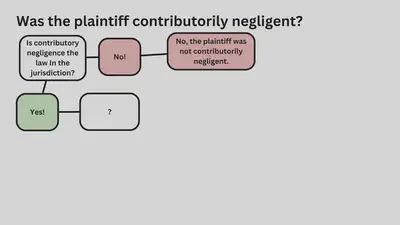
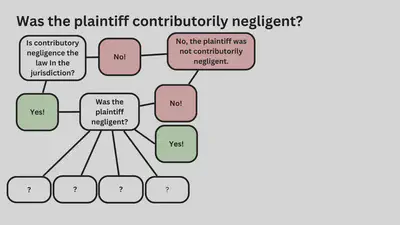
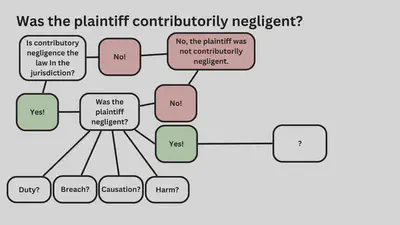
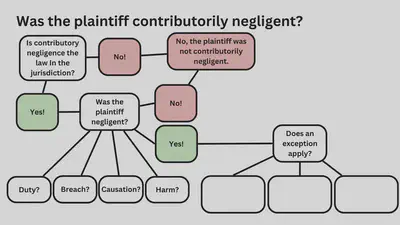

Li v. Yellow Cab Company
“Car Accident Comparative Negligence”
—
Comparative Negligence
Three forms:
- Pure comparative negligence
- “Not as great as”
- “No greater than”
Comparative Negligence
Three forms:
- Pure comparative negligence
- “Not as great as” = (Plaintiff less than 50% at fault)
- “No greater than” = (Plaintiff 50% or less at fault)
Can the negligent plaintiff recover damages?
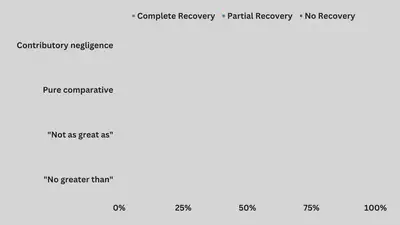
Can the negligent plaintiff recover damages?

That’s not
a flowchart!
It’s cool
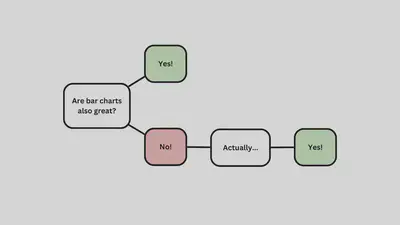
Can the negligent plaintiff recover damages?

Can the negligent plaintiff recover damages?

Can the negligent plaintiff recover damages?
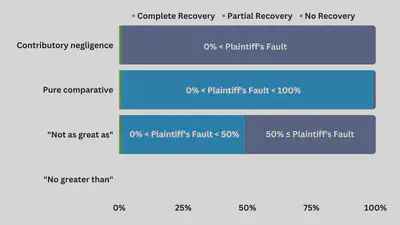
Can the negligent plaintiff recover damages?
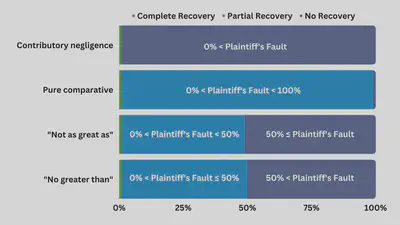
If multiple defendants are liable, how much are they each paying?
Doctrine of Contribution
Traditional Common Law Approach
Two versions:
- Joint and several liability
- Several liability
Apportionment based on factual cause
Don’t
forget about
factual cause!
Don’t forget about factual cause!
Tortfeasors are only liable for the injuries they caused.
Order of operations with multiple injuries and multiple liable defendants
First step:
Separate injuries based on factual cause.
Second step:
For injuries that multiple defendants caused, sort out liability based on the contribution rule in the jurisdiction.